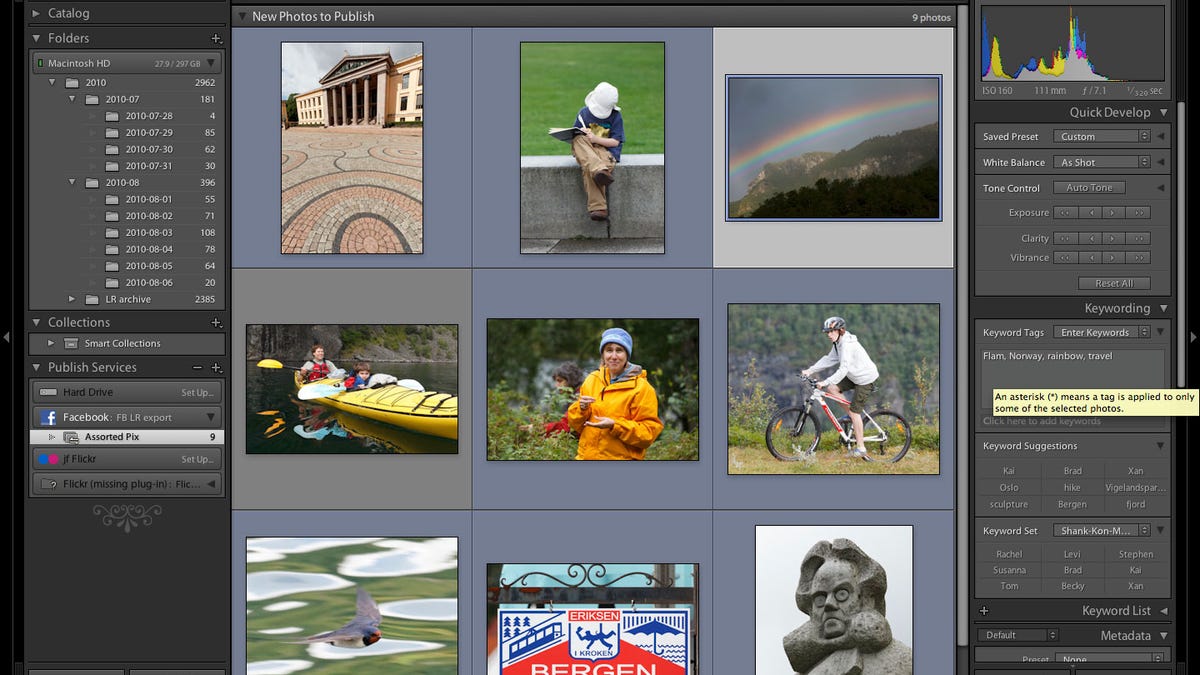Lightroom 3.2 to fix bugs, add Facebook support
A release candidate for Adobe's photo editing and cataloging software fixes problems, supports several new cameras and lenses, and sends your shots to Facebook.

Adobe Systems issued a release candidate for Lightroom 3.2 on Tuesday that fixes dozens of bugs, lets users publish photos to Facebook, adds automated optical corrections for dozens of lenses, and supports Pentax's new medium-format digital camera among other models.
Accompanying the software is a corresponding release candidate for Camera Raw 6.2, the Photoshop module that uses the same engine as Lightroom for converting raw files into more broadly supported, compact formats such as JPEG. Adobe skipped the Lightroom 3.1 number to synchronize the two related packages' release numbers.
If you want to fetch the software, try the Lightroom 3.2 download site or Camera Raw 6.2 download site on Adobe Labs.
One of Lightroom 3's significant new features is publishing, the ability not only to export photos to a Web site but to keep those exported photos in sync with those on a personal computer. That means changes to a photo--a tighter crop, brighter exposure, a new title--can be easily sent to the online version as well. It's a convenient option in today's world where photo libraries on PCs are mirrored online for easy viewing.
But there's a caveat for the Facebook publishing tool: an update doesn't slip seamlessly into place. Lightroom offers this warning when you try to republish a photo after an update in Lightroom: "All comments and likes will be lost on updated photos. Are you sure you want to do this?"
Despite the caveat, though, it's still worth using, especially if you are as put off as I am by Facebook's obtuse photo interface.
Lightroom is designed to catalog, edit, and export photos--particularly raw photos from higher-end cameras. Raw photos--the image sensor data without any in-camera processing into a JPEG--offer more flexibility and quality but require processing work on the photographer's part. And for software companies such as Adobe and Apple, raw support means keeping up with a constant flow of new cameras, most with a new proprietary raw format.
Sometimes Adobe sneaks more camera support in between betas or release candidates and final releases, and that might happen again. "The final releases of Lightroom 3.2 and Camera Raw 6.2 may have additional corrections or camera support," said Lightroom product manager Tom Hogarty in a blog post Tuesday.
The new Lightroom and Camera Raw software supports raw imagery from a host of new cameras, including several compact models with interchangeable lenses: the Sony NEX-3 and NEX-5 and the Samsung NX10. Also on the list are new compacts from Panasonic, the DMZ FZ100, FZ40 (aka FZ45), and LX5, and from Samsung, the TL500 (aka EX1). Casio's Exilim higher-end EX-FH100 compact and Leica's top-end S2 also get improved support when people use them to shoot with Adobe's Digital Negative (DNG) raw format.
In the core SLR market where photographers are inclined to shoot raw, the Adobe software adds support for Sony's newer Alpha A290 and A390 models.
Finally, Adobe built in support for Pentax's new high-end 645D camera, a high-end medium-format model aimed at landscape and studio photographers who want top image quality. That support includes lens profiles for 15 medium-format Pentax lenses, but somewhat perversely, there still aren't lens profiles for Pentax's years-old line of mainstream, less expensive SLRs.
The lens profile support lets Lightroom and Photoshop automatically correct chromatic aberration, distortion, and vignetting. That's a convenience for those who don't enjoy manual labor such as figuring out just how much red and cyan color fringes mar high-contrast edges.
Several Canon, Nikon, and Sigma lenses were supported already. The new release candidates add support for ten more Canon SLR lenses, for the compact PowerShot S90's lens, and for three more Nikon lenses. It also tweaks the profiles for a few Canon and Nikon lenses that already had been supported.
New to the lens profiles are support for some new Sigma and Samsung lenses and a sizeable list of Zeiss lenses for both Canon and Nikon SLRs.
Also, although Adobe hoped that Lightroom 3.0 would arrive a mature product, it had a number of bugs and other issues. Adobe fixes 70 of them, by my count, in the new release candidate.
That includes some that particularly annoyed me: "1:1 preview generation could appear to repeat itself for DNG files," "Scrolling or louping through many photos can cause Lightroom to start paging aggressively," "Copy as DNG selection not remembered for subsequent imports," and "Flickr Publish Collection publishes to a Photostream in the reverse of the expected order."
For the full list, check Hogarty's post.

